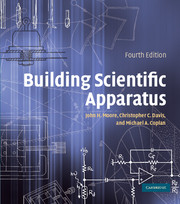1 - MECHANICAL DESIGN AND FABRICATION
Published online by Cambridge University Press: 05 August 2012
Summary
Every scientific apparatus requires a mechanical structure, even a device that is fundamentally electronic or optical in nature. The design of this structure determines to a large extent the usefulness of the apparatus. It follows that a successful scientist must acquire many of the skills of the mechanical engineer in order to proceed rapidly with an experimental investigation.
The designer of research apparatus must strike a balance between the makeshift and the permanent. Too little initial consideration of the expected performance of a machine may frustrate all attempts to get data. Too much time spent planning can also be an error, since the performance of a research apparatus is not entirely predictable. A new machine must be built and operated before all the shortcomings in its design are apparent.
The function of a machine should be specified in some detail before design work begins. One must be realistic in specifying the job of a particular device. The introduction of too much flexibility can hamper a machine in the performance of its primary function. On the other hand, it may be useful to allow space in an initial design for anticipated modifications. Problems of assembly and disassembly should be considered at the outset, since research equipment rarely functions properly at first and often must be taken apart and reassembled repeatedly.
Make a habit of studying the design and operation of machines. Learn to visualize in three dimensions the size and positions of the parts of an instrument in relation to one another.
- Type
- Chapter
- Information
- Building Scientific Apparatus , pp. 1 - 75Publisher: Cambridge University PressPrint publication year: 2009

